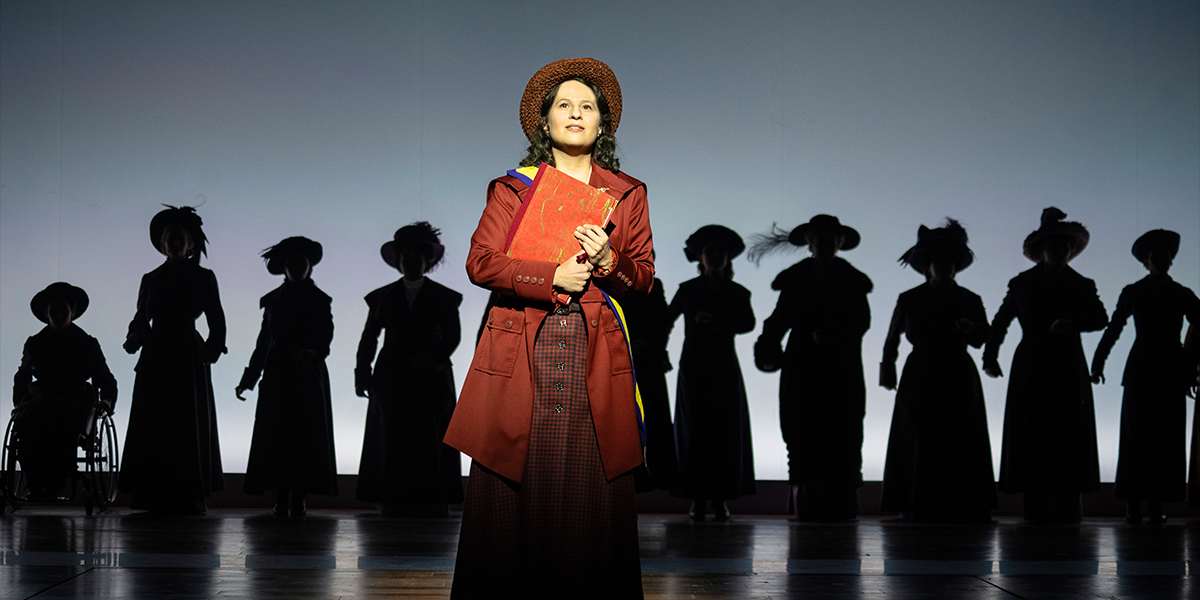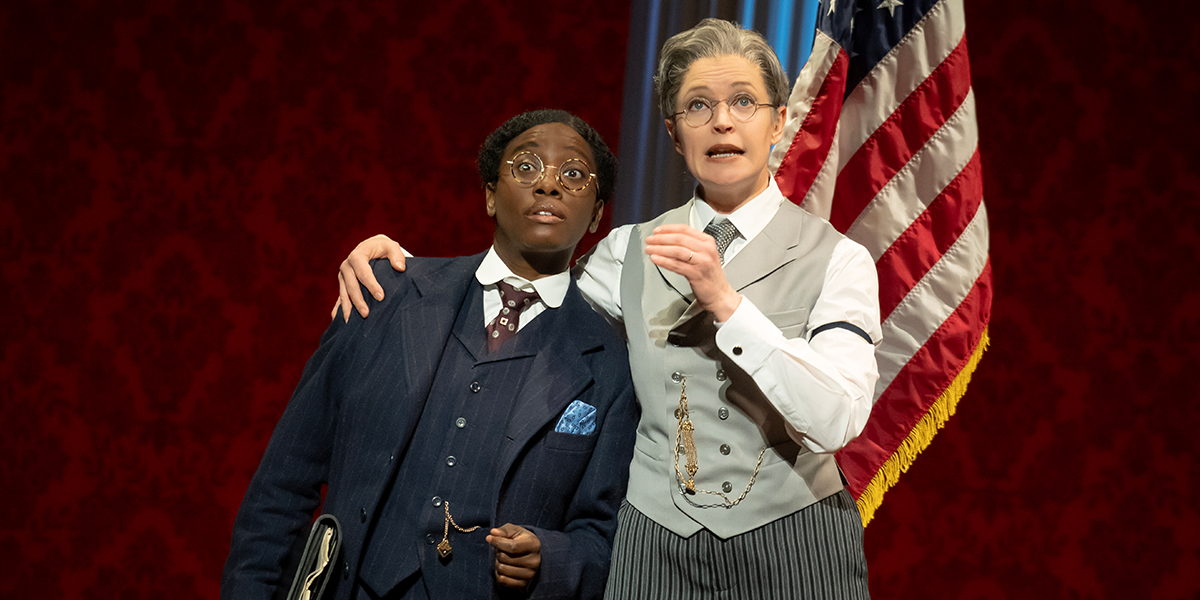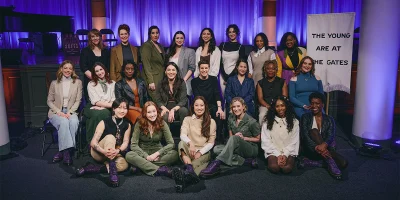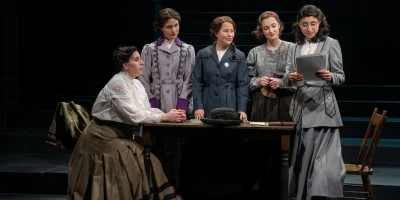
All the songs in 'Suffs' on Broadway
Learn more about the real people and events that inspired the score of Shaina Taub's six-time Tony Award-nominated musical about the women's suffrage movement.
Suffs may not be the first history musical, but creator Shaina Taub insists that one key difference sets it apart. While Americans are taught about the Founding Fathers (the subject of the history hit Hamilton) in school, many don’t learn as much about the suffrage movement — and how messy it got as women fought for the right to vote.
The musical, now playing on Broadway at the Music Box Theatre, is nominated for six Tony Awards, including Best Musical. The show is almost entirely sung through, and many of the songs are inspired by real people and events. Many are also new to the Broadway production, added after the show premiered off Broadway at The Public Theater in 2022.
Learn more about songs in Suffs and how they teach a new generation about the fight for suffrage.
“Let Mother Vote”
The opening number introduces Carrie Chapman Catt, a leading suffragist. Her platform uses the image of the virtuous, motherly woman using the vote to shape the nation’s “moral fiber,” which typified first-wave feminism.
Catt sings, “We nurture every family, just as we’re meant to do, so won’t you let us nurture the nation too?” But a central conflict in Suffs is that not every suffragist agrees with this approach by the turn of the 20th century.
“Let Mother Vote” was written for Suffs's Broadway run. The previous, satirical opener featured a chorus of vaudevillians warning men to stand guard against rowdy, unladylike suffragists.
“Finish the Fight”
“Finish the Fight” is a solo song by Alice Paul, the suffragist whose militant organizing led to the passage of the 19th Amendment. In this song, Paul dreams of “finishing the fight” of women’s suffrage and rejects the polite methods of Catt and her other predecessors.
Shaina Taub, who earned 2024 Tony Award nominations for writing the show’s book, music, and lyrics, stars as Paul.

“Find A Way”
This song introduces much of the rest of the Suffs ensemble: Lucy Burns, a good friend of Paul’s; Inez Milholland, a socialite and aspiring lawyer who becomes the glamorous face of suffrage; Ruza Wenclawska, a labor activist and Polish immigrant; and Doris Stevens, a young woman from Nebraska who becomes the group’s secretary.
That group, the Congressional Union for Woman Suffrage (known as CU), originally worked with Catt’s National American Woman Suffrage Association (NAWSA), but they disagreed with NAWSA's tactics.
“Find A Way” takes some liberties with history. Burns sings, “We’ve never planned a national action before,” but in reality, Burns, Paul, Milholland, and other suffragists trained with radical suffragist Emmeline Pankhurst in England and were imprisoned for their activism. Burns even went on to lead the Women’s Social and Political Union’s Scottish campaign for suffrage in 1911.
“Find A Way” also introduces a musical theme that recurs in two later songs (“Alva Belmont” and “Hold It Together”) and subtly references the Hamilton songs “One Last Time” and “The Election of 1800.”
“Wait My Turn”
This solo introduces Ida B. Wells, a suffragist, activist, and journalist best known for exposing the horrors of lynching to the American public. In this song, Wells rejects Paul’s awkward request for her to march in a segregated section at the back of a white women’s suffrage march.
Sung through immediately from “Find a Way,” "Wait My Turn" asks Paul to stand up against the Southern white women asking her to segregate the march. “You do have a choice,” Wells sings. “There’s always a choice. Which one will you make?”

“Terrell’s Theme”
As Black suffragist Mary Church Terrell prepares to attend the segregated march, she reminds her daughter Phyllis of their mantra: “And so, lifting as we climb, onward and upward we go.”
Terrell expressed this exact sentiment in an 1898 speech before the National Association of Colored Women, which she helped establish. “Lifting As We Climb” was, and still is, the organization’s motto. This phrase referred to the idea that more educated Black women needed to include those less educated in their fight for social rights.
Composers Lea Morris and Joan Szymko are two other songwriters who have set “Lifting As We Climb” to music.
“The March (We Demand Equality)”
As the march goes on, with Milholland on a white horse, this song shares the inner thoughts of the many women marching. “I’ve never felt so alive before,” they sing. “I feel a part of something bigger than me.”
After the marchers are attacked by “hundreds of hooligans” and fight back, “The March” introduces a refrain that recurs later in Suffs: “I want my mother to know I was here,” Paul sings, followed by Wells’s “I want my sisters to know I was here.” Others chime in about the legacy they will leave.

“G.A.B.”
This drinking song, also a new addition to Suffs on Broadway, uses an abbreviation to hide the punchline from the audience. When Doris is upset that a man called her a "bitch" at the march, the others assure her it’s a compliment.
“I’d rather be right than rich ‘cause I’m a great American bitch!” Wenclawska proudly sings, sharing how she was fired from her job for fighting against her boss’s sexual harassment.
The carefree number includes a refrain modern women are meant to relate to: “Drink if they’ve called you a nag, drink if they’ve called you a slut or a shrew, drink if they’ve called you a crazy hag, drink if the rumors are true!”
“Ladies”
Woodrow Wilson (played by a non-male performer in Suffs's all-female and non-binary cast) performs this silly song that masks his disdain for suffrage. However, he eventually sings: “If politics pollutes our ladies’s lives, I’m scared to say, we’ll sacrifice virility, and compromise fertility, and threaten the stability of the USA!”
Wilson’s legacy is associated with suffrage because he was in office when the 19th Amendment was passed, but he didn't support the movement. When he taught at the all-female Bryn Mawr College, he wrote in his personal papers that educating the students was “about as appropriate and profitable as would be lecturing to stone masons on the evolution of fashion in dress.” He also wrote to his wife that he got a “chilled, scandalized feeling [...] when I see and hear women speak in public.”
“A Meeting With President Wilson”
This song details the CU's meetings with President Wilson from 1913 to 1916, an election year. Wilson mostly pretends he never heard of the suffrage campaign.

“Worth It”
This pensive song sees Paul wondering if she could balance a personal life, including romance and a family, with her suffrage work. “What would my life look like if I wasn’t so consumed by this?” The song features Paul writing alone at her desk in a nod to Hamilton’s “Hurricane.”
In the end, Paul rejects a potential suitor. The real Paul never married and reportedly had few close friends.
“If We Were Married”
This upbeat number features Dudley Malone, a confidant of President Wilson, trying to woo Doris. But Doris schools Dudley on the realities of marriage for American women.
"If we were married, my earnings would be in your name and I couldn’t control my own spending, or open a bank account, or sign a contract, or hire a lawyer, because, economically speaking, I’d die by becoming your wife," she sings. Doris also points out that domestic violence committed by a husband against his wife was legal at the time.
“The Convention Part I”/This Girl/Part II
These songs are all set at a suffrage convention in 1916 Chicago. Taub introduces a phrase that returns in Act II’s “Hold It Together”: “Why are you fighting me? I am not the enemy.” Terrell and Wells ask this question of each other, as do Catt and Paul.
Catt sings “This Girl” as a solo, recounting her history with disenfranchisement as a widow. She vows not to let Paul’s efforts interfere with her plans for the suffrage movement. Paul's group campaigned to vote Wilson out of office if he won’t support suffrage, which angers Catt and the old guard. They fear that the younger activists make them look “like a horde of hysterical harpies.”
In the end, a new party splits off from NAWSA: The National Woman’s Party, led by Paul. Their first action is a nationwide tour, the Suffrage Special, to campaign against Wilson.

“Alva Belmont”
Now that Paul and the gang have a new party, they need someone to finance their tour. Enter Alva Belmont, a wealthy Southern socialite who married into (and then divorced out of) the Vanderbilt family.
Another devotee of Pankhurst, Belmont held suffrage meetings at her mansion in Newport, Rhode Island. She donated the money for the NWP to get a headquarters in Washington, D.C. after the 19th Amendment was passed in 1920, though the federal government later seized the building to break ground on the new Supreme Court.
The suffs ask Belmont, “How can we ever thank you?” Belmont croons, “Someday you’ll name it after me.” In 2016, President Barack Obama established the Belmont-Paul Women’s Equality National Monument at the home where the NWP had been headquartered since 1929.
“Show Them Who You Are”
Though Milholland remains committed to the cause, she confides in Paul that she doesn’t have the physical strength to tour. Paul tries to guilt Milholland into going. “I’m not gonna let you ‘Alice Paul’ me this time,” Milholland retorts, though she gives in and heads west.
Neither Paul nor the audience know yet that Milholland had anemia and traveled against the advice of doctors.
“The Campaign”
As Milholland devotes herself to getting men to vote against Wilson, the suffs are dismayed to watch him get reelected in 1916. Lucy then tells the others about Milholland’s death after she collapsed while giving a speech in Los Angeles.
“How Long?”
At Inez Milholland’s memorial, Paul shares information that gives this song its title: “The last thing she said was the question we’re now asking over and over as we look back, as we look forward: How long must women wait for liberty?” This question became a rallying cry that was frequently seen on suffrage protest banners in the 1910s.
The Act 1 finale ends with the projection of a newspaper photograph of the actual Milholland on horseback at the 1913 march.

“The Young Are at the Gates”
This number details the Silent Sentinels, a protest movement led by Paul's group that began outside the White House in early 1917. Although protests are common today, they used to be unusual and were not something a "proper woman" would join, even though the Sentinels were peaceful and used silence as a protest tactic.
“But day by day, more women came from all corners of the country,” the suffs sing, noting that the protesters included working-class women, Black suffragists like Terrell, and college students. “And what started as a dozen turned to hundreds within weeks.”
The Washington Post reported that the goal of the protests was to make it “impossible for the President to enter or leave the White House without encountering a sentinel.”
In a callback to “The March (We Demand Equality),” the Sentinels face abuse from mobs, and police arrest the suffragists.
“Respectfully Yours, Dudley Malone”
This song dramatizes Malone’s actual resignation letter, which he published in the New York Times in September 1917 in protest against the Wilson administration’s treatment of the Silent Sentinels.
Malone was crucial to Wilson’s first presidential campaign, but he resigned from the post of Collector of Customs for the Port of New York. Malone wrote that he would “give all my leisure time to fight as hard for the political freedom of women as I have always fought for your [Wilson’s] liberal leadership.”
“Hold It Together”
In England in 1910, Paul was imprisoned for her suffrage activities, embarked on a hunger strike, and was subjected to force-feeding. She wrote in a letter to her sister Helen that she would never go on hunger strike again. But as history and this song attests, she did while imprisoned in America, encouraging the other suffs to join her. The hunger leads to infighting among the suffs and the return of the refrain “Why are you fighting me? I am not the enemy.”
Meanwhile, Catt tries to use women’s home-front support of World War I as a way to further paint women as moral victors worthy of the vote, singing, “Let mother serve.”

“Wait My Turn (Reprise)”
This song discusses Wells’s national anti-lynching campaigns. She repeats a refrain from Act I’s “How Long?”, now focused on the fight against hate crimes.
As in the first “Wait My Turn,” Wells points out that Black suffragists must navigate both racism and sexism, a concept later feminist scholars would refer to as “double jeopardy.”
“The Report”
While Wilson presents a false report on the conditions of the imprisoned suffs, the women describe the force-feeding, which included having raw eggs sent through tubes into their stomachs. In the graphic number, they ask the audience not to believe Wilson: “Don’t let them tell you we take this well.”
“Show Them Who You Are (Reprise)”
Isolated in the prison’s psychiatric ward due to her hunger strike, an ailing Paul sees a vision of Milholland. “You are the bravest person I’ve ever met, but bravery means that you can’t die yet,” Milholland sings, begging Paul to end her hunger strike.
“Insane”
With prison officials and the Wilson administration threatening to commit Paul to a psychiatric hospital, Paul debates giving up her hunger strike. “In a world that’s gone crazy, am I crazy to hope?” Paul sings of the diagnosis that may be thrust onto her.
Scholar Jean H. Baker writes in the book Sisters: The Lives of America’s Suffragists that the Wilson administration sent a journalist to the jail to try to speak to Paul at night, hoping doctors would believe she was suffering from paranoia and delusions.

“Fire & Tea”
This song features the suffs burning an effigy of Wilson, with onstage pyrotechnics. This did occur in February 1919, and many of the protestors were arrested, including Lucy Burns. Suffragists also kept a “watch fire” burning outside the White House, vowing to tend it until a suffrage amendment was passed. “Let the fire rage on,” they sing.
Meanwhile, someone leaks the women’s accounts of prison to the press (in this song, it’s Stevens), wreaking havoc in the Wilson administration. Wilson agrees to meet with Catt while the suffragists gain sympathy from the American public. Catt suggests Wilson work with her to stop the protests and bad press.
“Let Mother Vote (Reprise)”
Wilson embraces suffrage to regain public trust, singing Catt’s motto of “Let mother vote.” Though Taub places the effigy burning in 1918 for the musical, it actually occurred one night in 1919 before Senate was set to vote on the suffrage amendment. Wilson had endorsed suffrage in a speech before Congress in 1918, but didn’t rally senators in time for the vote.
“She And I”
Catt and Paul meet again in Tennessee, awkwardly making small talk as they wait to see if they have one more state’s approval — enough for the amendment. Despite trying to be polite, they soon begin lobbing insults.
“I hope you realize if we lose, it will be due to the backing you cost us by picketing the president during the war,” Catt sings. “I hope you realize if we win, it will be despite the power you lost us by bowing to the president during the war,” Paul shoots back.
Catt then returns to “This Girl,” admitting that Paul reminds her of herself when she first joined the suffrage movement.
“A Letter From Harry’s Mother”
Phoebe Burn, the mother of Tennessee state senator Harry T. Burn, takes the stage. The senator was only 24 when he was in office, and he claimed to have this letter from his mother in his pocket when he cast his vote for suffrage— surprising his colleagues and the suffragists.
In the song, Phoebe Burn says she wishes she had the right to vote so she could vote against Wilson, as she lost her husband in World War I. “Let your mama know she raised a good one,” she writes.
Phoebe Burn later said that the Louisiana governor's wife asked her to say that the letter was a fraud and redact her support for suffrage, but Burn refused.
“I Was Here”
This song repeats lyrics from “The March” and dramatizes Terrell informing Wells of the passage of the amendment. Despite initial joy, Terrell and Wells both know Southern states will deny Black women the vote, just as they did with Black men.

“If We Were Married (Reprise)”
Now that suffrage is reality, Stevens agrees to marry Dudley Malone. The pair wed in 1921, and Stevens purposefully retained her given surname. Though it doesn’t make for a good ending to a musical, the couple divorced in 1929.
This song parallels their marriage with the relationship between Catt and Mollie Hay, a suffragist who lived with Catt and was, by many accounts, her life partner. Here, Catt and Hay sing “if we were married,” whereas Stevens and Malone sing “when we are married.”
“Lucy’s Song”
This song gives Lucy Burns her flowers after her many years of fighting for suffrage. It’s true that by 1920, Burns was burnt out, so to speak.
Christine Lunardini reported in the book From Equal Suffrage to Equal Rights that Burns wanted to pass the baton to the next generation of women: “I think we have done all this for women, and we have sacrificed everything we possessed for them, and now let them fight for it now. I am not going to fight anymore.”
“Finish the Fight (Reprise)”
It’s true that Paul only briefly recharged after the passage of the 19th Amendment before devoting herself to her next project: The Equal Rights Amendment (which has not been passed). She first presented a draft of the ERA to Congress in 1923, and alongside law school, Paul spent the rest of her life advocating for the bill.
In 1972, when women’s liberation activists thought they had a shot at getting the amendment passed, Paul was in her 80s, still campaigning for the bill. As a second-wave feminist character implies in this song, not everyone agreed with Paul’s approach. Suddenly Paul finds herself “the old fogy” she once called Catt. Paul died in 1977 at the height of the second-wave movement.
“Keep Marching”
This song closes Suffs with a call to action to the next generation. “Your ancestors are all the proof you need that progress is possible, not guaranteed,” Paul sings. The ensemble joins her to remind the audience of the solidarity necessary to make change: “Let history sound the alarm of how the future demands that we fight for it now.”
Frequently asked questions
What is Suffs about?
See a historical, history-making original musical as it marches onto Broadway. Suffs details the lives and legacies of the pioneers of the women's suffrage movement, taking a celebratory but honest look at their triumphs and imperfections alike.
Where is Suffs playing?
Suffs is playing at Music Box Theatre. The theatre is located at 239 West 45th Street (between Broadway and 8th Avenue), New York, 10036.
How long is Suffs?
The running time of Suffs is 2hr 30min. Incl. 15min intermission.
What's the age requirement for Suffs?
The recommended age for Suffs is Ages 10+. Children under 4 are not allowed in the theatre..
How do you book tickets for Suffs?
Book tickets for Suffs on New York Theatre Guide.
Who wrote Suffs?
Shaina Taub wrote the book, music, and lyrics for Suffs. She is also known for co-writing The Devil Wears Prada musical with Elton John and adapting multiple Shakespeare plays into musicals for The Public Theater.
Who directed Suffs on Broadway?
Tony Award nominee Leigh Silverman (Violet) is the director of Suffs. She directed the musical both on and off Broadway.
What are the songs in Suffs?
The score for Suffs, written entirely by Shaina Taub, features songs with titles including "The Young Are At the Gates," "The Strong One," "Ladies," "This Girl," and "How Long."
Is Suffs appropriate for kids?
Suffs on Broadway has not yet set an age recommendation. Please note that children 4 and younger are not permitted in Broadway theatres.
Is Suffs good?
Suffs is among the best-reviewed shows on New York Theatre Guide, with our four-star review of the play's Off-Broadway premiere hailing it as "a historical and history-making musical... the future of musical theatre is female, and it's about time."
Originally published on








